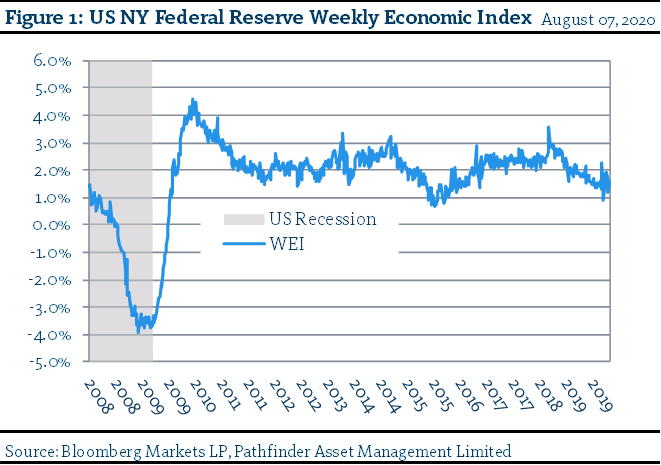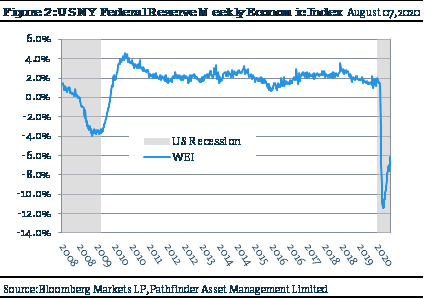High Frequency Data
Every morning at Pathfinder we have a “Desk Chat”. We always had some banter around The Desk but with the recent change to our work environment, we started a morning Microsoft Teams video session so that we can “feel” we are together. Bill even links in from his NHL Bubble. This week, Lucas brought up a topic that sparked some lively debate. He presented the Google Trends page to the investment team and asked our opinion of using the real-time search data to drive investment decisions. The team basically broke into two camps: one that likes computers and algorithms advocating for using the data to get trading strategy in advance and one group that might be considered a little more “stubborn” who advocated for a much more slow-moving measured valuation type approach. In the end, we all concluded that while faster and more data is interesting, investors are now inundated. This is very different than when I started in the business, when we waited for financial statements to come in the mail once a quarter. The real trick is to figure what information is relevant to a particular investment thesis and focus on that, rather than trying to absorb a broad more shallow data set. I did want to point out a high frequency (meaning faster & more data points) index that we found recently that seems interesting:
- The New York Fed Weekly Economic Index (WEI) is a blend of ten different daily and weekly series covering consumer behavior, the labor market, and production. The “approach serves to filter out the high level of noise prevalent in individual weekly releases while also providing a more representative measure than any one weekly data series”. It is basically a broad measure of economic activity (retail sales, employment, steel production, electricity usage, fuel sales, railroad traffic and tax receipts) using some of the data points that we often reference in this note, along with some others that we do not have ready access to.

- I have included two charts of the WEI. Figure 1 to the end of January 2020 before the pandemic started and Figure 2 which shows the impact so far to the end of last week. The grey bars are recessions as defined by the National Bureau of Economic Research. While economic impact has been severe, there has been some improvement recently. We still have a long way back.

“This means that” that while we will follow the index on a regular basis it will have limited impact on our actual trading activity. It would be nice to see general improvement in the economy, so it is useful from that point of view, but we will continue to invest in businesses based on our traditional valuation framework.
Disclosure
National Instrument 31-103 requires registered firms to disclose information that a reasonable investor would expect to know, including any material conflicts with the firm or its representatives. Doug Johnson and/or Pathfinder Asset Management Limited are an insider of companies periodically mentioned in this report. Please visit www.paml.ca for full disclosures.
*All returns are time weighted and net of investment management fees. Returns from the Pathfinder Partners’ Fund and Pathfinder Real Fund are presented based on the masters series of each fund. The Pathfinder North American Equity Portfolio and The Pathfinder North American Income Portfolio are live accounts. These are actual accounts owned by the Pathfinder Chairman (Equity) and client (High Income) which contain no legacy positions, cash flows or other Pathfinder investment mandates or products. Monthly inception dates for each fund and portfolio are as follows: Pathfinder North American Equity Portfolio (January 2011), Pathfinder North American High-Income Portfolio (October 2012) Pathfinder Partners’ Fund (April 2011), Pathfinder Real Fund (April, 2013), and Pathfinder International Fund (November 2014).
Pathfinder Asset Management Limited (PAML) and its affiliates may collectively beneficially own in excess of 10% of one or more classes of the issued and outstanding equity securities mentioned in this newsletter. This publication is intended only to convey information. It is not to be construed as an investment guide or as an offer or solicitation of an offer to buy or sell any of the securities mentioned in it. The author has taken all usual and reasonable precautions to determine that the information contained in this publication has been obtained from sources believed to be reliable and that the procedures used to summarize and analyze such information are based on approved practices and principles in the investment industry. However, the market forces underlying investment value are subject to sudden and dramatic changes and data availability varies from one moment to the next. Consequently, neither the author nor PAML can make any warranty as to the accuracy or completeness of information, analysis or views contained in this publication or their usefulness or suitability in any particular circumstance. You should not undertake any investment or portfolio assessment or other transaction on the basis of this publication, but should first consult your portfolio manager, who can assess all relevant particulars of any proposed investment or transaction. PAML and the author accept no liability of any kind whatsoever or any damages or losses incurred by you as a result of reliance upon or use of this publication.